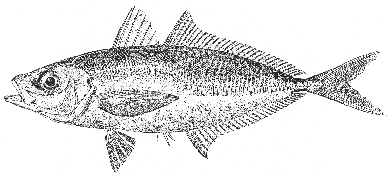Saurel Trachurus trachurus (Linnaeus) 1758
ROUGH SCAD
[Jordan and Evermann, 1899-1900, p. 910.[71]]

Figure 202.—Saurel (Trachurus trachurus), Rhode Island. From Goode. Drawing by H. L. Todd.
Description—
The saurel is distinguishable from all allied species yet known from New England waters by having about 75 bony plates along its lateral lines, as contrasted with about 30 or fewer in other Gulf of Maine carangids. It is a somewhat deeper fish than the mackerel scad but more slender than the hardtail or the crevalle, its body (to the base of tail) being about 3½ times as long as it is deep. Its first dorsal fin, of 8 spines, is closely followed by the long second dorsal of 25 to 30 soft rays. Its soft anal, opposite the second dorsal, has 24 to 26 rays, and is preceded by two small detached spines. The tail is deeply forked.
Color—
Described as bluish green above, silvery below, with a black spot on the edge of the gill cover above its rear angle.
Size—
Length about one foot.
General range—
Known from nearly all warm and temperate seas, sometimes common, off the Florida Keys. A few have been recorded from the vicinity of New York, one from Newport, R. I., and three from the Gulf of Maine.
Occurrence in the Gulf of Maine—
One specimen of this rare fish was taken in Casco Bay on August 12, a second at Castine, Maine, on October 15, 1930,[72] and a third at Sandwich, Mass., on Cape Cod Bay in the summer of 1950.[73]
[71] Nichols (Bull. Amer. Mus. Nat. Hist., vol. 42, 1920, p. 479) considers the western Atlantic saurel distinct from the eastern Atlantic saurel and has proposed the name lathami for it. But this separation has not been adopted generally.
[72] Kendall, Bull. No. 58, Boston Soc. of Nat. Hist., 1931, p. 11.
[73] We received this specimen from Capt. Benjamin Morrow and it is now in the Museum of Comparative Zoology.